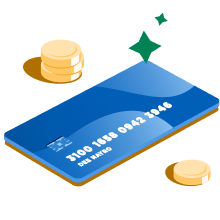How to Apply for an SBA Loan in 5 Steps

Many or all of the products featured here are from our partners who compensate us. This influences which products we write about and where and how the product appears on a page. However, this does not influence our evaluations. Our opinions are our own. Here is a list of our partners and here's how we make money.
U.S. Small Business Administration loans typically offer long repayment terms and low interest rates. As a result, these small-business loans are among the most affordable and sought-after forms of funding for entrepreneurs — but SBA loan applications are also among the most rigorous.
By taking the time to understand the process and your loan options, however, you’ll put yourself in the best position to apply and get approved.
Here are five steps to apply for an SBA loan.
How much do you need?
We’ll start with a brief questionnaire to better understand the unique needs of your business.
Once we uncover your personalized matches, our team will consult you on the process moving forward.
1. Choose the right SBA loan for your needs
There are three main SBA loan programs: the 7(a) loan program, the CDC/504 loan program and the microloan program.
SBA 7(a) loans are issued by participating lenders, like banks and credit unions. 504 loans, on the other hand, come from three sources — a third-party lender, a Certified Development Company (CDC) and the borrower. Both of these loan types are partially-guaranteed by the SBA.
With microloans, the SBA funds intermediary lenders (typically nonprofits and community organizations) directly and they completely process, distribute and administer the loans themselves.
Here’s an overview of these three SBA loan options:
SBA loan type | Loan amount | Repayment term | Interest rates | Use cases |
|---|---|---|---|---|
Up to $5 million. | 10 years for equipment, working capital or inventory loans; 25 years for real estate. | 11.5% to 15% | Working capital, debt refinancing, equipment purchases, changes of ownership. | |
Up to $5 million (up to $5.5 million for select projects). | 10, 20 or 25 years, based on the remaining useful life of the property being financed. | Rates are tied to the 10-year U.S. Treasury notes and are typically around 5% to 7% of the amount financed. | Purchase or upgrade of large, fixed assets. | |
Up to $50,000. | Up to seven years. | Rates vary, but typically range from 8% to 13%. | Working capital; purchase of business supplies and equipment. |
Ultimately, the right SBA loan for you will depend on why you need funding, how much funding you need and your qualifications, among other factors.
2. Determine if you qualify for an SBA loan
SBA loan requirements will vary based on your loan program and lender — but you’ll also have to meet a set of standard criteria laid out by the SBA. These qualifications include:
Must be a for-profit business operating in the U.S.
Must be a small business, as defined by the SBA.
Must be able to demonstrate the need for the loan funds and show how you’ll use them.
Must have sought out other forms of financing before turning to an SBA loan.
Must be able to show that you’re creditworthy and that you can repay a loan.
Cannot be delinquent on any existing government loans.
If you can meet these requirements, you’ll then need to confirm that you can qualify with an SBA lender. Because 7(a) and 504 loans are issued by traditional lenders, they tend to have more stringent criteria than microloans. You’ll typically need:
Good credit (score of 650 to 680 or higher).
Strong revenue.
Multiple years in business.
For microloans, on the other hand, you may be able to qualify with a credit score of 620 or higher and less than two years in business.
If you don’t think you can qualify for an SBA loan, you might pivot your search to online lenders. These companies typically have more flexible qualification requirements and faster funding times compared to bank and SBA lenders.
3. Find an SBA lender
You’ll want to find an SBA lender that has sufficient experience processing and issuing SBA loans — and one that offers the loan type you’re looking for.
To start, you can try reaching out to a bank or financial institution with which you have a previous relationship. Popular small-business banks like Bank of America, Wells Fargo and Chase, for example, each offer 7(a) and 504 loans.
You can also browse a list of active CDCs and a list of active microlenders on the SBA’s website.
To connect with lenders directly, you can use the SBA’s lender match system. With Lender Match, you’ll answer a few questions about your business and in two days, you’ll receive an email with possible lender matches. You can then contact the lenders for more information and compare their rates, terms and fees.
4. Prepare your SBA loan application
The details of your SBA loan application will vary slightly based on your lender and loan type. In general, however, you’ll need to provide the following documentation:
SBA-specific forms
SBA Form 1919, Borrower Information Form.
SBA Form 912, Statement of Personal History.
SBA Form 413, Personal Financial Statement.
SBA Form 148, Unconditional Guarantee (or the lender’s equivalent). The SBA requires that anyone with 20% or more ownership in the business provide an unlimited personal guarantee. Owners with less than 20% ownership may provide a full or limited guarantee (SBA Form 148L).
Financial statements
Current income statement and balance sheet.
Income statements and balance sheets from the previous three years.
Cash flow projections.
Three years of business tax returns (or all tax returns to date).
Three years of personal tax returns.
Existing debt schedule, if applicable.
Detailed listing of all collateral.
Supporting documents
Business certificates or licenses.
Loan application history.
Resumes for each business owner.
Business overview and history.
Business lease.
If you’re using your SBA loan to buy a business, finance a franchise or purchase real estate, you may be required to provide additional documentation.
5. Submit your SBA loan application package
Once you’ve gathered all of your documentation, it can be helpful to have a mentor or business advisor look over your loan application in its entirety. They can point out missing pieces of information or help you strengthen any weak spots to increase your chances of approval.
Then, you’ll submit the application to your SBA lender. The lender will underwrite your application and decide whether or not to approve the loan.
If you’re approved, the lender will send your application to the SBA for review. During this process, the SBA may re-request documents or ask for additional information. Once you’re approved by the SBA, you’ll receive an initial commitment of your loan terms and you’ll start the closing process.
It’s important to note that not all SBA lenders have to send their applications to the SBA for review. Preferred lending partners, or PLPs, can make final credit decisions without SBA approval, thereby expediting the application process.
Microloans are also not subject to SBA review, as these intermediary lenders have the authority to process, distribute and close loans on their own.
Overall, it can take anywhere from 30 to 90 days to get an SBA loan. PLP and microlenders can likely offer the fastest timelines, but SBA loans will still be slower to fund than many other small-business loan options.
Find the right business loan
The best business loan is generally the one with the lowest rates and most ideal terms. But other factors — like time to fund and your business’s qualifications — can help determine which option you should choose. NerdWallet recommends comparing small-business loans to find the right fit for your business.
A version of this article originally appeared on Fundera, a subsidiary of NerdWallet.
On a similar note...






